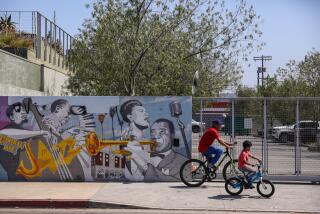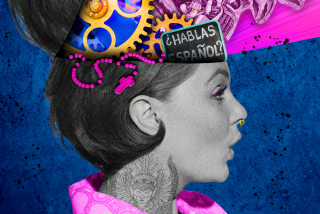Column: Chicanos Would Find Identity Before Coalition With Blacks
Mexicans and Negroes are learning that they must know each other better if their differences are not to help those who would like to kill the civil rights movement.
This necessary lesson is not easy to come by.
Blacks, scarred by the bitter and sometimes bloody struggle for equality, consider Mexican-Americans or Chicanos as Johnnies-come-lately who should follow black leadership until the Chicanos earn their spurs.
Chicanos, not untouched by bigotry and wary of more sophisticated black leadership, insist on going their own way because, as they put it, “our problems are different from those of the Negroes.”
Despite the loud mouthings of radicals, most blacks and Chicanos want the same thing: a fair chance to enter the mainstream of American society without abandoning their culture and uniqueness.
Much has been made of late of the growing rift between Negroes and Mexican-Americans. Chicanos complain that blacks get most of the government help in the fight against racism, while Negroes scoff that Mexican-Americans have not carried their share of the burden in the civil rights movement.
Leaders of both communities throw up their arms in despair, saying that the blacks and brows are fighting over peanuts and that political coalitions must be formed to make a real impact on the establishment.
Blacks and browns have always been cast together by the forces of history and the needs of these two peoples.
Los Angeles, for instance, was founded not by Spanish caballeros, as romantics would have it, but by blacks and browns.
Historian H.H. Bancroft points out that Los Angeles was founded on Sept. 4, 1781, with 12 settlers and their families, 46 persons in all, “whose blood was a strange mixture of Indian (Mexican) and Negro with here and there a trace of Spanish.”
C.D. Willard, another historian, adds that “cataloguing this extraordinary collection of adults by nationality or color, we have two Spaniards, one mestizo, two Negroes, eight mullatoes and nine (Mexican) Indians.”
The children of the settlers, continues Willard, were even more mixed, as follows: Spanish-Indian, four; Spanish-Negro, five; Negro-Indian, eight; Spanish-Negro-Indian, three; Indian, two.
Since then, Mexicans and Negroes have more or less followed their own separate destinies, due partly to their culture and language differences but also because of the racist strain in American society.
Mexican-Americans have a saying about Negroes that goes, “Juntos per no revueltos”—together but not mixed. Negroes, on the other hand, tend to think of Mexican-Americans—as do many Anglosas—as “quaint and foreign.”
One hundred and eighty years after the small group of black and brown people settled in what became Los Angeles, however, six Mexican-American children and six Negro children are involved in a Superior Court ruling in which Judge Alfred Gitelson ordered the Los Angeles school district desegregated.
When the Los Angeles school district is finally integrated, history will again have thrown the blacks and the browns together again.
To understand why Mexicans and Negroes are having their differences now, one must look at it in the light of the black revolution.
The revolution exploded partly from a condition which had been known all along but which became the basis for a black-white confrontation: the color of one’s skin is all too important in America. White is good. Black is bad.
Faced with an identity crisis, many Mexican-Americans—especially the young who were excited by black militancy—decided they had been misled by the Mexican establishment into apathetic confusion.
It came as a shock at first: Mexican-Americans felt caught between the white and the black. Though counted as “White” by the Bureau of Census, Mexican-Americans were never really thought of as such.
The ambivalence felt vaguely and in silence for so long seemed to crystalize in the wake of the black revolution. A Mexican-American was neither Mexican nor American. He was neither white nor black.
One of the reasons for the growing distrust between Mexicans and Negroes is that the Chicano is still searching for his identity.
As yet, most Mexican-Americans seem not to identify with any one single overriding problem as Americans. Though they know they’re somehow different, many still cling to the idea that Mexican-Americans are Caucasian, thus white, this “one of the boys.”
Many prove it: By looking and living like white Americans, by obtaining and keeping good jobs and by intermarrying with Anglos who never think of it as a “mixed marriage.”
Many others, however, feel they have for too long been cheated by tacitly agreeing to be Caucasian in name only. These Mexican-Americans, especially the young Chicanos, feel that the coalition with the Anglos has failed.
And they’re not about ready to form a new coalition—this time with the blacks—until they, the Chicanos, find their own identity in their own way.
More to Read
Sign up for Essential California
The most important California stories and recommendations in your inbox every morning.
You may occasionally receive promotional content from the Los Angeles Times.











